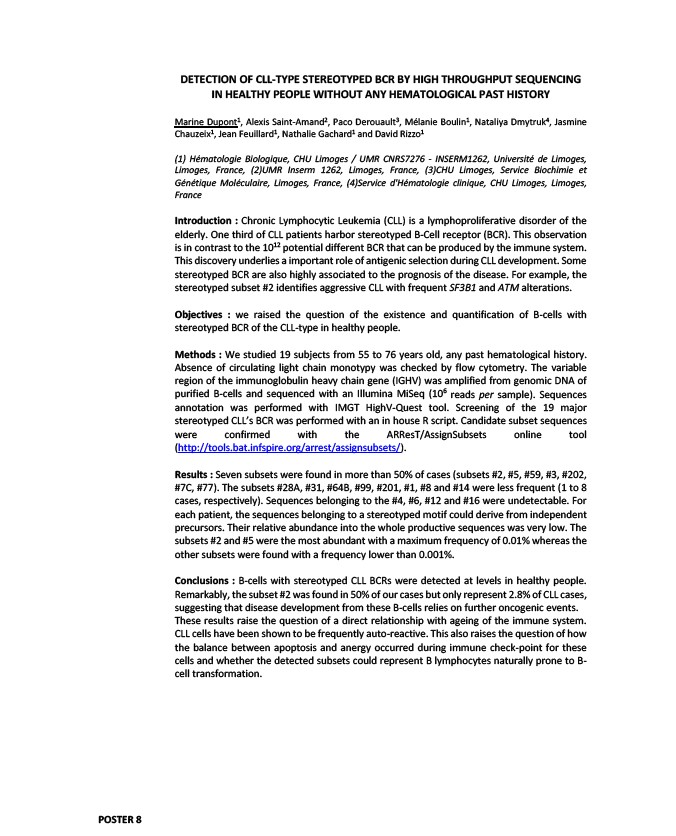
DETECTION OF CLL-TYPE STEREOTYPED BCR BY HIGH THROUGHPUT SEQUENCING
IN HEALTHY PEOPLE WITHOUT ANY HEMATOLOGICAL PAST HISTORY
Marine Dupont1, Alexis Saint-Amand2, Paco Derouault3, Mélanie Boulin1, Nataliya Dmytruk4, Jasmine
Chauzeix1, Jean Feuillard1, Nathalie Gachard1 and David Rizzo1
(1) Hématologie Biologique, CHU Limoges / UMR CNRS7276 - INSERM1262, Université de Limoges,
Limoges, France, (2)UMR Inserm 1262, Limoges, France, (3)CHU Limoges, Service Biochimie et
Génétique Moléculaire, Limoges, France, (4)Service d'Hématologie clinique, CHU Limoges, Limoges,
France
Introduction : Chronic Lymphocytic Leukemia (CLL) is a lymphoproliferative disorder of the
elderly. One third of CLL patients harbor stereotyped B-Cell receptor (BCR). This observation
is in contrast to the 1012 potential different BCR that can be produced by the immune system.
This discovery underlies a important role of antigenic selection during CLL development. Some
stereotyped BCR are also highly associated to the prognosis of the disease. For example, the
stereotyped subset #2 identifies aggressive CLL with frequent SF3B1 and ATM alterations.
Objectives : we raised the question of the existence and quantification of B-cells with
stereotyped BCR of the CLL-type in healthy people.
Methods : We studied 19 subjects from 55 to 76 years old, any past hematological history.
Absence of circulating light chain monotypy was checked by flow cytometry. The variable
region of the immunoglobulin heavy chain gene (IGHV) was amplified from genomic DNA of
purified B-cells and sequenced with an Illumina MiSeq (106 reads per sample). Sequences
annotation was performed with IMGT HighV-Quest tool. Screening of the 19 major
stereotyped CLL’s BCR was performed with an in house R script. Candidate subset sequences
were confirmed with the ARResT/AssignSubsets online tool
(http://tools.bat.infspire.org/arrest/assignsubsets/).
Results : Seven subsets were found in more than 50% of cases (subsets #2, #5, #59, #3, #202,
#7C, #77). The subsets #28A, #31, #64B, #99, #201, #1, #8 and #14 were less frequent (1 to 8
cases, respectively). Sequences belonging to the #4, #6, #12 and #16 were undetectable. For
each patient, the sequences belonging to a stereotyped motif could derive from independent
precursors. Their relative abundance into the whole productive sequences was very low. The
subsets #2 and #5 were the most abundant with a maximum frequency of 0.01% whereas the
other subsets were found with a frequency lower than 0.001%.
Conclusions : B-cells with stereotyped CLL BCRs were detected at levels in healthy people.
Remarkably, the subset #2 was found in 50% of our cases but only represent 2.8% of CLL cases,
suggesting that disease development from these B-cells relies on further oncogenic events.
These results raise the question of a direct relationship with ageing of the immune system.
CLL cells have been shown to be frequently auto-reactive. This also raises the question of how
the balance between apoptosis and anergy occurred during immune check-point for these
cells and whether the detected subsets could represent B lymphocytes naturally prone to B-cell
transformation.
POSTER 8